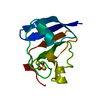+ Open data
Open data
- Basic information
Basic information
| Entry | Database: PDB / ID: 6yac | ||||||||||||||||||||||||||||||
|---|---|---|---|---|---|---|---|---|---|---|---|---|---|---|---|---|---|---|---|---|---|---|---|---|---|---|---|---|---|---|---|
| Title | Plant PSI-ferredoxin supercomplex | ||||||||||||||||||||||||||||||
 Components Components |
| ||||||||||||||||||||||||||||||
 Keywords Keywords | PHOTOSYNTHESIS / Membrane complex / photosystem I / ferredoxin / light harvesting / excitation transfer | ||||||||||||||||||||||||||||||
| Function / homology |  Function and homology information Function and homology informationphotosynthesis, light harvesting in photosystem I / photosynthesis, light harvesting / chloroplast thylakoid lumen / photosystem I reaction center / photosystem I / photosynthetic electron transport in photosystem I / photosystem I / photosystem II / chloroplast stroma / chlorophyll binding ...photosynthesis, light harvesting in photosystem I / photosynthesis, light harvesting / chloroplast thylakoid lumen / photosystem I reaction center / photosystem I / photosynthetic electron transport in photosystem I / photosystem I / photosystem II / chloroplast stroma / chlorophyll binding / chloroplast thylakoid membrane / photosynthesis / electron transport chain / 2 iron, 2 sulfur cluster binding / 4 iron, 4 sulfur cluster binding / oxidoreductase activity / electron transfer activity / protein domain specific binding / magnesium ion binding / metal ion binding Similarity search - Function | ||||||||||||||||||||||||||||||
| Biological species |  Pisum sativum (garden pea) Pisum sativum (garden pea) | ||||||||||||||||||||||||||||||
| Method | ELECTRON MICROSCOPY / single particle reconstruction / cryo EM / Resolution: 2.5 Å | ||||||||||||||||||||||||||||||
 Authors Authors | Caspy, I. / Nelson, N. / Shkolnisky, Y. / Klaiman, D. / Sheinker, A. | ||||||||||||||||||||||||||||||
| Funding support |  Israel, 2items Israel, 2items
| ||||||||||||||||||||||||||||||
 Citation Citation |  Journal: Nat Plants / Year: 2020 Journal: Nat Plants / Year: 2020Title: The structure of a triple complex of plant photosystem I with ferredoxin and plastocyanin. Authors: Ido Caspy / Anna Borovikova-Sheinker / Daniel Klaiman / Yoel Shkolnisky / Nathan Nelson /  Abstract: The ability of photosynthetic organisms to use sunlight as a sole source of energy is endowed by two large membrane complexes-photosystem I (PSI) and photosystem II (PSII). PSI and PSII are the ...The ability of photosynthetic organisms to use sunlight as a sole source of energy is endowed by two large membrane complexes-photosystem I (PSI) and photosystem II (PSII). PSI and PSII are the fundamental components of oxygenic photosynthesis, providing oxygen, food and an energy source for most living organisms on Earth. Currently, high-resolution crystal structures of these complexes from various organisms are available. The crystal structures of megadalton complexes have revealed excitation transfer and electron-transport pathways within the various complexes. PSI is defined as plastocyanin-ferredoxin oxidoreductase but a high-resolution structure of the entire triple supercomplex is not available. Here, using a new cryo-electron microscopy technique, we solve the structure of native plant PSI in complex with its electron donor plastocyanin and the electron acceptor ferredoxin. We reveal all of the contact sites and the modes of interaction between the interacting electron carriers and PSI. | ||||||||||||||||||||||||||||||
| History |
|
- Structure visualization
Structure visualization
| Movie |
 Movie viewer Movie viewer |
|---|---|
| Structure viewer | Molecule:  Molmil Molmil Jmol/JSmol Jmol/JSmol |
- Downloads & links
Downloads & links
- Download
Download
| PDBx/mmCIF format |  6yac.cif.gz 6yac.cif.gz | 907.4 KB | Display |  PDBx/mmCIF format PDBx/mmCIF format |
|---|---|---|---|---|
| PDB format |  pdb6yac.ent.gz pdb6yac.ent.gz | 771.5 KB | Display |  PDB format PDB format |
| PDBx/mmJSON format |  6yac.json.gz 6yac.json.gz | Tree view |  PDBx/mmJSON format PDBx/mmJSON format | |
| Others |  Other downloads Other downloads |
-Validation report
| Summary document |  6yac_validation.pdf.gz 6yac_validation.pdf.gz | 14.7 MB | Display |  wwPDB validaton report wwPDB validaton report |
|---|---|---|---|---|
| Full document |  6yac_full_validation.pdf.gz 6yac_full_validation.pdf.gz | 15.5 MB | Display | |
| Data in XML |  6yac_validation.xml.gz 6yac_validation.xml.gz | 236.6 KB | Display | |
| Data in CIF |  6yac_validation.cif.gz 6yac_validation.cif.gz | 288.9 KB | Display | |
| Arichive directory |  https://data.pdbj.org/pub/pdb/validation_reports/ya/6yac https://data.pdbj.org/pub/pdb/validation_reports/ya/6yac ftp://data.pdbj.org/pub/pdb/validation_reports/ya/6yac ftp://data.pdbj.org/pub/pdb/validation_reports/ya/6yac | HTTPS FTP |
-Related structure data
| Related structure data |  10746MC  6yezC M: map data used to model this data C: citing same article ( |
|---|---|
| Similar structure data |
- Links
Links
- Assembly
Assembly
| Deposited unit | 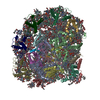
|
|---|---|
| 1 |
|
- Components
Components
-Photosystem I P700 chlorophyll a apoprotein ... , 2 types, 2 molecules AB
| #1: Protein | Mass: 82571.484 Da / Num. of mol.: 1 / Source method: isolated from a natural source / Source: (natural)  Pisum sativum (garden pea) / References: UniProt: A0A0F6NFW5, photosystem I Pisum sativum (garden pea) / References: UniProt: A0A0F6NFW5, photosystem I |
|---|---|
| #2: Protein | Mass: 82381.734 Da / Num. of mol.: 1 / Source method: isolated from a natural source / Source: (natural)  Pisum sativum (garden pea) / References: UniProt: A0A0F6NGI2, photosystem I Pisum sativum (garden pea) / References: UniProt: A0A0F6NGI2, photosystem I |
-Protein , 10 types, 10 molecules CDEFGHL12N
| #3: Protein | Mass: 8860.276 Da / Num. of mol.: 1 / Source method: isolated from a natural source / Source: (natural)  Pisum sativum (garden pea) / References: UniProt: P10793, photosystem I Pisum sativum (garden pea) / References: UniProt: P10793, photosystem I |
|---|---|
| #4: Protein | Mass: 16041.408 Da / Num. of mol.: 1 / Source method: isolated from a natural source / Source: (natural)  Pisum sativum (garden pea) / References: UniProt: E1C9K8*PLUS Pisum sativum (garden pea) / References: UniProt: E1C9K8*PLUS |
| #5: Protein | Mass: 7479.422 Da / Num. of mol.: 1 / Source method: isolated from a natural source / Source: (natural)  Pisum sativum (garden pea) / References: UniProt: E1C9K6*PLUS Pisum sativum (garden pea) / References: UniProt: E1C9K6*PLUS |
| #6: Protein | Mass: 17137.857 Da / Num. of mol.: 1 / Source method: isolated from a natural source / Source: (natural)  Pisum sativum (garden pea) / References: UniProt: A0A0M3KL12*PLUS Pisum sativum (garden pea) / References: UniProt: A0A0M3KL12*PLUS |
| #7: Protein | Mass: 10678.027 Da / Num. of mol.: 1 / Source method: isolated from a natural source / Source: (natural)  Pisum sativum (garden pea) Pisum sativum (garden pea) |
| #8: Protein | Mass: 9491.742 Da / Num. of mol.: 1 / Source method: isolated from a natural source / Source: (natural)  Pisum sativum (garden pea) / References: UniProt: A0A0M3KL10*PLUS Pisum sativum (garden pea) / References: UniProt: A0A0M3KL10*PLUS |
| #12: Protein | Mass: 16564.977 Da / Num. of mol.: 1 / Source method: isolated from a natural source / Source: (natural)  Pisum sativum (garden pea) / References: UniProt: E1C9L1*PLUS Pisum sativum (garden pea) / References: UniProt: E1C9L1*PLUS |
| #13: Protein | Mass: 21335.439 Da / Num. of mol.: 1 / Source method: isolated from a natural source / Source: (natural)  Pisum sativum (garden pea) Pisum sativum (garden pea) |
| #14: Protein | Mass: 22845.812 Da / Num. of mol.: 1 / Source method: isolated from a natural source / Source: (natural)  Pisum sativum (garden pea) / References: UniProt: Q41038 Pisum sativum (garden pea) / References: UniProt: Q41038 |
| #17: Protein | Mass: 10359.312 Da / Num. of mol.: 1 / Source method: isolated from a natural source / Source: (natural)  Pisum sativum (garden pea) / References: UniProt: P09911 Pisum sativum (garden pea) / References: UniProt: P09911 |
-Photosystem I reaction center subunit ... , 3 types, 3 molecules IJK
| #9: Protein/peptide | Mass: 3409.198 Da / Num. of mol.: 1 / Source method: isolated from a natural source / Source: (natural)  Pisum sativum (garden pea) / References: UniProt: P17227 Pisum sativum (garden pea) / References: UniProt: P17227 |
|---|---|
| #10: Protein/peptide | Mass: 4767.609 Da / Num. of mol.: 1 / Source method: isolated from a natural source / Source: (natural)  Pisum sativum (garden pea) / References: UniProt: D5MAL3 Pisum sativum (garden pea) / References: UniProt: D5MAL3 |
| #11: Protein | Mass: 8135.471 Da / Num. of mol.: 1 / Source method: isolated from a natural source / Source: (natural)  Pisum sativum (garden pea) / References: UniProt: E1C9L3 Pisum sativum (garden pea) / References: UniProt: E1C9L3 |
-Chlorophyll a-b binding protein ... , 2 types, 2 molecules 34
| #15: Protein | Mass: 24139.521 Da / Num. of mol.: 1 / Source method: isolated from a natural source / Source: (natural)  Pisum sativum (garden pea) / References: UniProt: Q32904 Pisum sativum (garden pea) / References: UniProt: Q32904 |
|---|---|
| #16: Protein | Mass: 21994.029 Da / Num. of mol.: 1 / Source method: isolated from a natural source / Source: (natural)  Pisum sativum (garden pea) / References: UniProt: Q9SQL2 Pisum sativum (garden pea) / References: UniProt: Q9SQL2 |
-Sugars , 2 types, 14 molecules 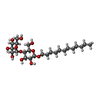


| #24: Sugar | ChemComp-LMT / #27: Sugar | ChemComp-DGD / |
|---|
-Non-polymers , 14 types, 285 molecules 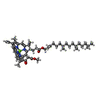

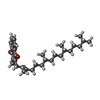





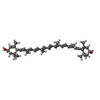
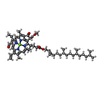
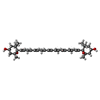
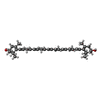
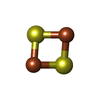














| #18: Chemical | ChemComp-CL0 / | ||||||||||||||||||||||||
|---|---|---|---|---|---|---|---|---|---|---|---|---|---|---|---|---|---|---|---|---|---|---|---|---|---|
| #19: Chemical | ChemComp-CLA / #20: Chemical | #21: Chemical | #22: Chemical | ChemComp-BCR / #23: Chemical | ChemComp-LHG / #25: Chemical | ChemComp-LMG / #26: Chemical | #28: Chemical | ChemComp-LUT / ( #29: Chemical | ChemComp-CHL / #30: Chemical | #31: Chemical | ChemComp-C7Z / ( | #32: Chemical | ChemComp-FES / | #33: Water | ChemComp-HOH / | |
-Details
| Has ligand of interest | N |
|---|---|
| Has protein modification | Y |
-Experimental details
-Experiment
| Experiment | Method: ELECTRON MICROSCOPY |
|---|---|
| EM experiment | Aggregation state: PARTICLE / 3D reconstruction method: single particle reconstruction |
- Sample preparation
Sample preparation
| Component | Name: Pea Photosystem I in complex with Ferredoxin / Type: COMPLEX / Entity ID: #1-#17 / Source: NATURAL |
|---|---|
| Molecular weight | Value: 0.66 MDa / Experimental value: NO |
| Source (natural) | Organism:  Pisum sativum (garden pea) Pisum sativum (garden pea) |
| Buffer solution | pH: 8 |
| Specimen | Embedding applied: NO / Shadowing applied: NO / Staining applied: NO / Vitrification applied: YES |
| Vitrification | Cryogen name: ETHANE |
- Electron microscopy imaging
Electron microscopy imaging
| Experimental equipment |  Model: Titan Krios / Image courtesy: FEI Company |
|---|---|
| Microscopy | Model: FEI TITAN KRIOS |
| Electron gun | Electron source:  FIELD EMISSION GUN / Accelerating voltage: 300 kV / Illumination mode: FLOOD BEAM FIELD EMISSION GUN / Accelerating voltage: 300 kV / Illumination mode: FLOOD BEAM |
| Electron lens | Mode: BRIGHT FIELD / Nominal defocus max: 3000 nm / Nominal defocus min: 900 nm |
| Specimen holder | Cryogen: NITROGEN |
| Image recording | Electron dose: 1.075 e/Å2 / Film or detector model: GATAN K3 (6k x 4k) / Num. of grids imaged: 1 / Num. of real images: 3669 |
- Processing
Processing
| Software |
| ||||||||||||||||||||||||||||||||||||
|---|---|---|---|---|---|---|---|---|---|---|---|---|---|---|---|---|---|---|---|---|---|---|---|---|---|---|---|---|---|---|---|---|---|---|---|---|---|
| EM software |
| ||||||||||||||||||||||||||||||||||||
| CTF correction | Type: NONE | ||||||||||||||||||||||||||||||||||||
| Particle selection | Num. of particles selected: 1776870 | ||||||||||||||||||||||||||||||||||||
| Symmetry | Point symmetry: C1 (asymmetric) | ||||||||||||||||||||||||||||||||||||
| 3D reconstruction | Resolution: 2.5 Å / Resolution method: FSC 0.143 CUT-OFF / Num. of particles: 269657 / Symmetry type: POINT | ||||||||||||||||||||||||||||||||||||
| Atomic model building | Protocol: AB INITIO MODEL / Space: REAL | ||||||||||||||||||||||||||||||||||||
| Atomic model building |
| ||||||||||||||||||||||||||||||||||||
| Refinement | Cross valid method: NONE Stereochemistry target values: GeoStd + Monomer Library + CDL v1.2 | ||||||||||||||||||||||||||||||||||||
| Displacement parameters | Biso mean: 48.74 Å2 | ||||||||||||||||||||||||||||||||||||
| Refine LS restraints |
|
 Movie
Movie Controller
Controller




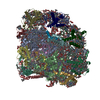
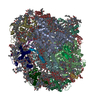
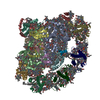

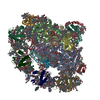


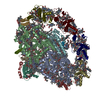
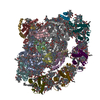
 PDBj
PDBj




























